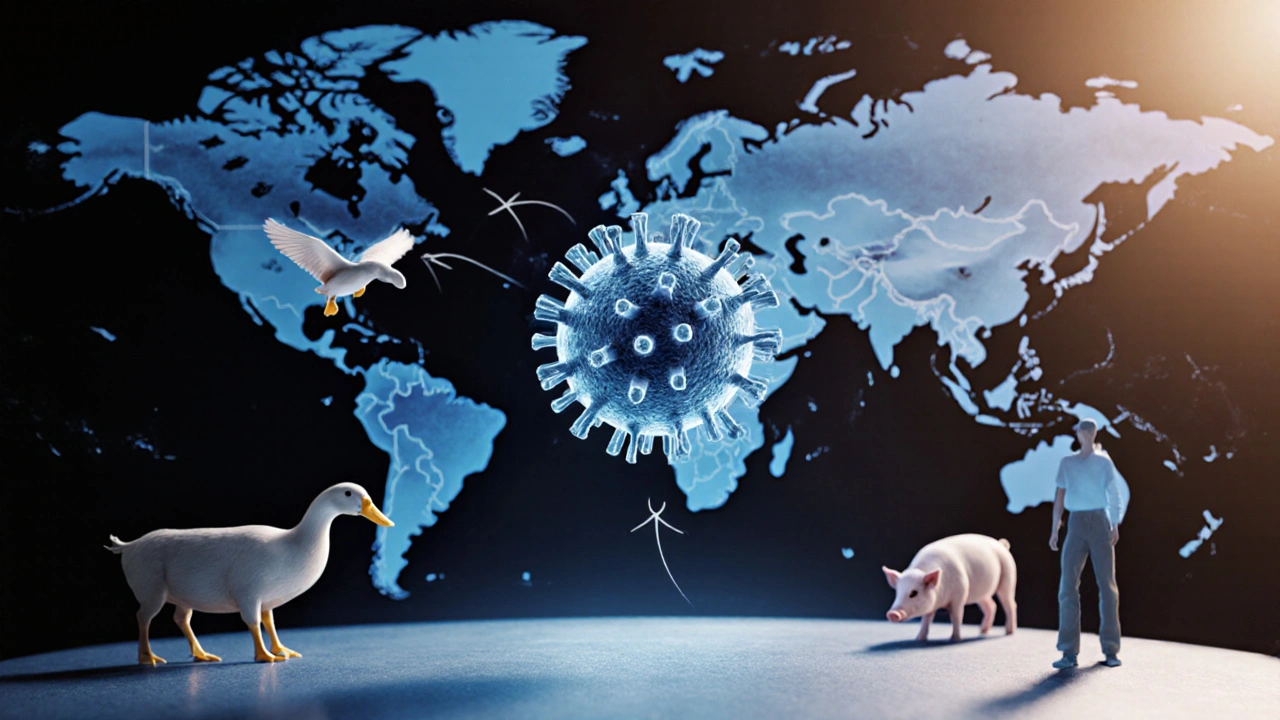Global Influenza Response Checker
This interactive tool evaluates how well your country is prepared for a global influenza response by checking against key pillars and recommendations.
Assessment Criteria
Rate your country's preparedness on a scale of 1 to 5 for each criterion:
Your Country's Preparedness Score
When influenza is described as a highly contagious respiratory virus that mutates rapidly and can jump between animal species and humans, it’s clear why a coordinated global effort is essential. Recent spikes in H3N2 and H5N1 cases across multiple continents have reminded us that the virus doesn’t respect borders. This article breaks down why the world must act together, what the core pillars of a global response look like, and how countries can avoid the costly mistakes of the past.
Key Takeaways
- Influenza’s ability to change (antigenic drift and shift) fuels re‑emergence and makes isolated national responses insufficient.
- Effective global response hinges on four pillars: real‑time surveillance, rapid vaccine manufacturing, equitable antiviral distribution, and strong international coordination.
- Historical pandemics (1918, 2009, 2022) illustrate that early data sharing saves lives and reduces economic loss.
- A practical checklist helps governments evaluate readiness and plug gaps before the next wave hits.
- Public trust and clear communication are as important as medical tools in curbing spread.
Why Influenza Keeps Coming Back
Influenza viruses belong to the Orthomyxoviridae family. Two biological tricks keep them ahead of our defenses:
- Antigenic drift - tiny mutations accumulate each season, altering surface proteins (hemagglutinin and neuraminidase) enough to evade existing immunity.
- Antigenic shift - when two different flu strains infect the same host (often pigs or birds), they can swap gene segments, creating a brand‑new subtype that most humans have never seen.
Climate change, urbanization, and intensified livestock trade increase the frequency of animal‑human spillovers, turning isolated outbreaks into regional threats.

The Four Pillars of a Global Response
International health bodies have converged on a four‑pillar framework that works like a safety net.
1. Real‑Time Surveillance & Data Sharing
Early detection relies on a network of laboratories, hospitals, and even wastewater monitoring sites. The World Health Organization (WHO) runs the Global Influenza Surveillance and Response System (GISRS), a coalition of 150+ national labs that uploads weekly strain data to a shared repository. The United States Centers for Disease Control and Prevention (CDC) contributes its FluView platform, offering real‑time dashboards that other nations can reference.
2. Rapid, Flexible Vaccine Production
Traditional egg‑based vaccine manufacturing takes 4-6 months-a lag that can render the final product mismatched to the circulating strain. New platforms like cell‑based and mRNA vaccines cut lead times to under 8 weeks. Countries that have invested in domestic mRNA facilities (e.g., South Korea, Canada) can scale up doses within weeks of a strain update, dramatically reducing the window of vulnerability.
3. Equitable Antiviral Distribution
Neuraminidase inhibitors (oseltamivir, zanamivir) and newer polymerase‑targeting drugs work best when administered early. The WHO’s Pandemic Influenza Preparedness Framework encourages pre‑positioning stockpiles in low‑resource regions, but many nations still face shortages. A coordinated procurement pool-similar to the COVAX model for COVID‑19 vaccines-could ensure that high‑risk groups receive treatment regardless of national wealth.
4. Strong International Coordination & Legal Frameworks
The International Health Regulations (IHR) provide legal obligations for reporting public health emergencies of international concern. When countries comply, the WHO can issue travel advisories, coordinate border screenings, and mobilize rapid response teams. However, compliance varies; the 2022 H5N1 outbreak in Europe exposed gaps in timely data sharing, leading to delayed vaccine strain updates.
Learning from Past Outbreaks
Comparing three major influenza events highlights how each pillar evolved.
| Aspect | 1918 Spanish Flu | 2009 H1N1 Pandemic | 2022 H5N1 Reemergence |
|---|---|---|---|
| Surveillance | Very limited; relied on newspaper reports | Global GISRS network operational | Real‑time genomic sequencing in 30+ countries |
| Vaccine production time | ~12 months (experimental) | ~6 months (egg‑based) | ~8 weeks (mRNA and cell‑based) |
| Antiviral availability | None | Oseltamivir widely stocked | Pre‑positioned stockpiles in 20 nations |
| International coordination | Ad‑hoc, no legal framework | IHR triggered early alerts | IHR compliance mixed; WHO issued joint statements |
Each iteration shows progress but also lingering weaknesses-especially in equitable access and rapid data exchange.
Checklist for Nations Preparing a Global‑Scale Response
- Enroll in GISRS and commit to weekly strain uploads.
- Establish at least one domestic mRNA vaccine production line or secure regional contracts.
- Maintain a strategic reserve of neuraminidase inhibitors equal to 5% of the population.
- Adopt the IHR reporting template and conduct annual simulation drills.
- Deploy community‑level risk communication teams trained in culturally appropriate messaging.
- Partner with neighbouring countries for cross‑border screening protocols.
- Allocate budget for real‑time digital surveillance tools (e.g., syndromic dashboards, wastewater monitoring).
Following these steps reduces the time from detection to vaccination from months to weeks.

Common Pitfalls and How to Avoid Them
- Under‑estimating mutation speed: Relying on a single vaccine strain for an entire season can leave large groups vulnerable. Use a multi‑strain approach and update forecasts quarterly.
- Supply chain bottlenecks: Egg‑based facilities are vulnerable to avian disease outbreaks. Diversify with cell‑based and mRNA platforms to keep production flowing.
- Public mistrust: Mixed messages from health ministries erode compliance. Centralize communication through a single trusted spokesperson and use plain language.
- Delayed reporting: Political concerns may suppress early case numbers. Embed legal penalties for non‑compliance within the IHR framework.
Looking Ahead: Building Resilience for the Next Wave
Influenza will continue to reemerge as long as humans interact closely with animal reservoirs. Investing in One‑Health research-where veterinarians, ecologists, and clinicians share data-creates a predictive edge. Artificial‑intelligence models that combine climate data, migratory bird patterns, and viral genomics can flag high‑risk zones months before human cases appear.
In short, a global influenza response that unites surveillance, rapid vaccine technology, fair drug distribution, and robust legal coordination isn’t just ideal-it’s the only realistic way to keep mortality and economic disruption in check.
Frequently Asked Questions
What makes influenza different from the common cold?
Influenza causes systemic symptoms like high fever, muscle aches, and severe fatigue, while the common cold is usually limited to a runny nose and mild sore throat. Flu also leads to higher rates of hospitalization and can trigger complications such as pneumonia.
Why can’t we just rely on seasonal flu vaccines?
Seasonal vaccines target the strains predicted to circulate each year. When a new subtype emerges (e.g., H5N1), the existing vaccine offers little protection, necessitating a rapid redesign and production of a matching vaccine.
How does the WHO decide which flu strains to include in the vaccine?
Twice a year, WHO convenes the GISRS experts who review global surveillance data, look at antigenic characteristics, and model potential spread. They then recommend the three or four strains that best match the circulating viruses.
Can antiviral drugs replace vaccines?
Antivirals are a crucial back‑up, but they work best when started early and don’t provide lasting immunity. Vaccines remain the primary tool for preventing infection and reducing community spread.
What role do travelers play in spreading influenza?
Travelers can carry the virus across continents within hours. That's why many countries issue travel advisories, require health declarations, and increase airport screening during a global flu surge.

i think global flu prep is a must, but many places still lag behind.
the tapestry of influenza whispers of nature's restless mutability, urging humanity to stitch together a shared net of vigilance and compassion across borders.
When we examine the historical record of influenza, we see a pattern that is both sobering and instructive; each pandemic has revealed gaps in our collective preparedness. The 1918 Spanish flu swept the globe with a lethality that modern medicine struggled to contain, largely because real‑time surveillance was a non‑existent concept at the time. Fast forward to 2009, the H1N1 outbreak showcased the benefits of the GISRS network, yet even then vaccine production lagged behind the virus's rapid spread. In 2022, the re‑emergence of H5N1 highlighted how climate‑driven migration of birds can seed new viral lineages across continents. These episodes teach us that surveillance, vaccine agility, antiviral equity, and legal coordination are not optional pillars but essential foundations. Real‑time data sharing allows health authorities to model transmission trajectories with unprecedented precision, enabling earlier public health interventions. Rapid vaccine platforms, especially mRNA, compress manufacturing timelines from months to weeks, shaving crucial days off the response curve. Equitable antiviral distribution prevents the virus from finding refuge in underserved regions, a factor that can prolong a pandemic's tail. Strong international legal frameworks, like the International Health Regulations, create obligations that encourage transparency and rapid reporting. However, compliance remains uneven; political considerations sometimes delay reporting, as seen in the delayed H5N1 notifications in some European states. The lesson is clear: without a unified, legally binding commitment, data gaps will persist. Moreover, public trust hinges on consistent, clear communication; mixed messages sow confusion and erode compliance. One‑Health approaches, integrating veterinary, ecological, and human health data, can anticipate zoonotic spillovers before they become human outbreaks. Artificial‑intelligence models that synthesize climate, migratory, and genomic data are beginning to flag hotspots months in advance. Investment in these predictive tools is a cost‑effective hedge against future waves. In sum, the convergence of surveillance, rapid vaccine tech, fair drug access, and robust legal mechanisms forms the only viable defense against the ever‑evolving influenza virus.
The data you presented underscores a moral imperative: nations that hoard resources betray global solidarity. Real‑time sharing of viral genomes is not merely scientific best practice-it is an ethical duty. Failure to act responsibly invites unnecessary suffering.
Love the optimism! 🌍 When countries pool their vaccine tech, we all win-no one gets left behind. Keep the momentum going! 😊
its a real thing.
One cannot help but observe that the discourse surrounding influenza preparedness has, in many respects, become an exercise in grandiloquence, replete with ostentatious terminology that obscures rather than elucidates. The sheer magnitude of the threat compels us to adopt a lexicon befitting the gravitas of the situation, yet we must be wary of alienating the lay public with excessive verbosity. Indeed, the mingling of technical jargon with lofty prose risks creating a barrier that impedes the very collaboration that is essential for a coordinated response. While the four‑pillar framework is undeniably sound, its articulation must balance scholarly precision with accessible clarity. Moreover, the historical vignettes you cite-1918, 2009, 2022-serve as poignant reminders that progress is contingent upon sustained investment, not episodic fervor. It would be remiss not to emphasize that the efficacy of mRNA platforms, while revolutionary, is contingent upon equitable manufacturing and distribution networks, lest we replicate past inequities. In closing, the imperative is clear: we must marry intellectual rigor with pragmatic inclusivity, lest the chorus of well‑intentioned experts become an echo chamber devoid of actionable outcomes.
While the analysis is thorough, it borders on verbosity that diminishes its practical impact. The recommendations, though sound, lack concrete timelines and accountability mechanisms. A more disciplined approach would better serve policymakers.